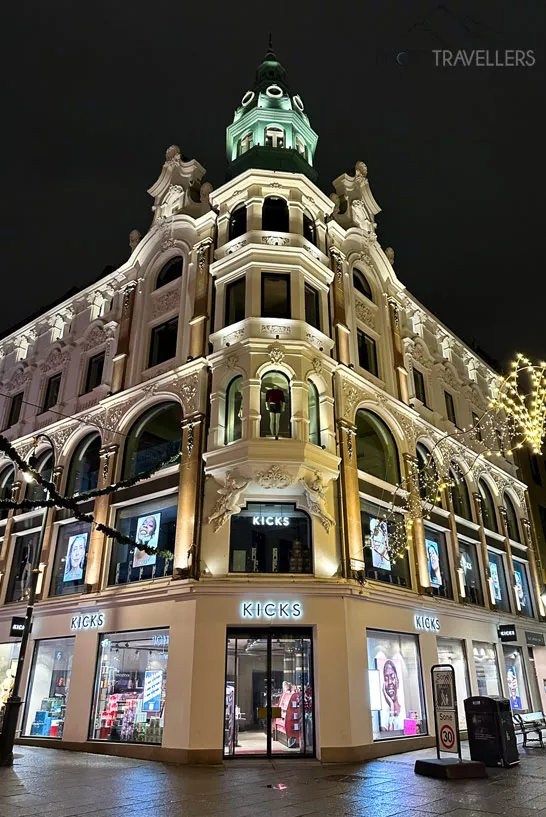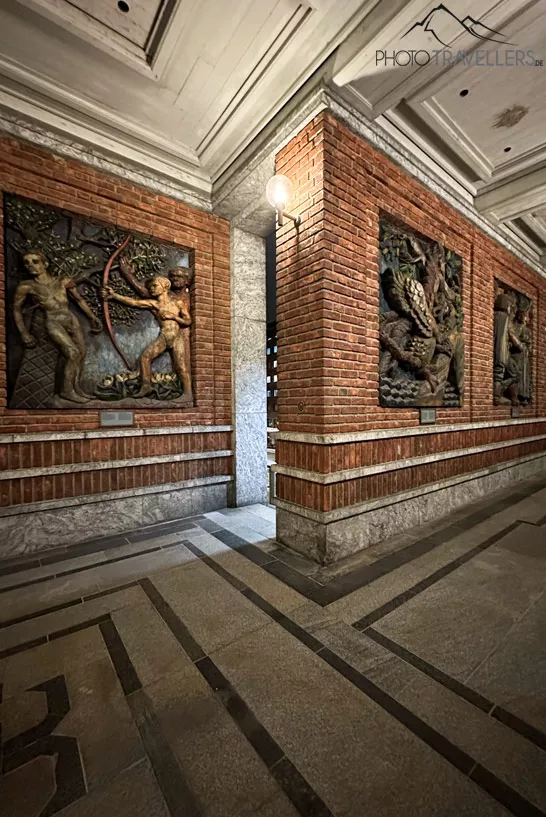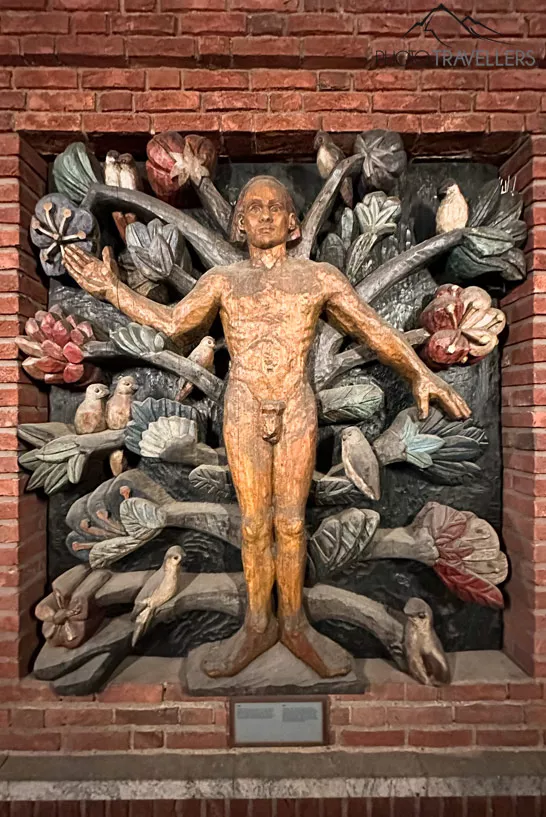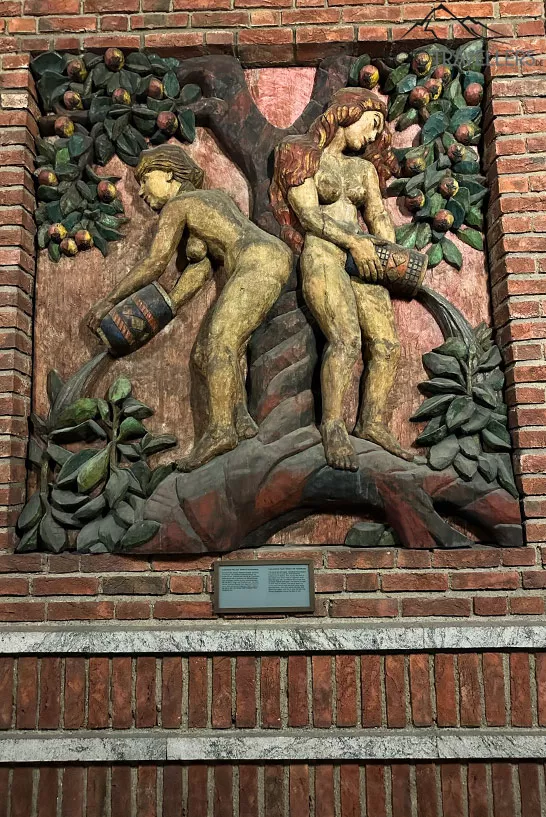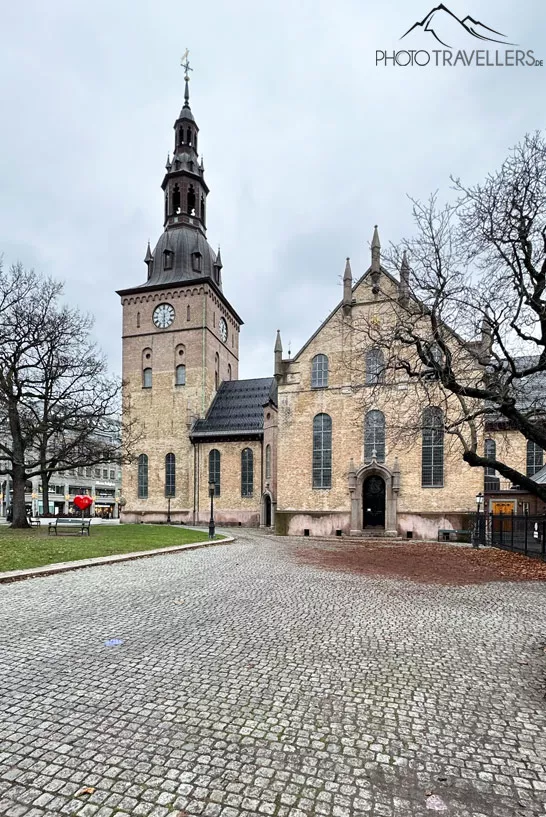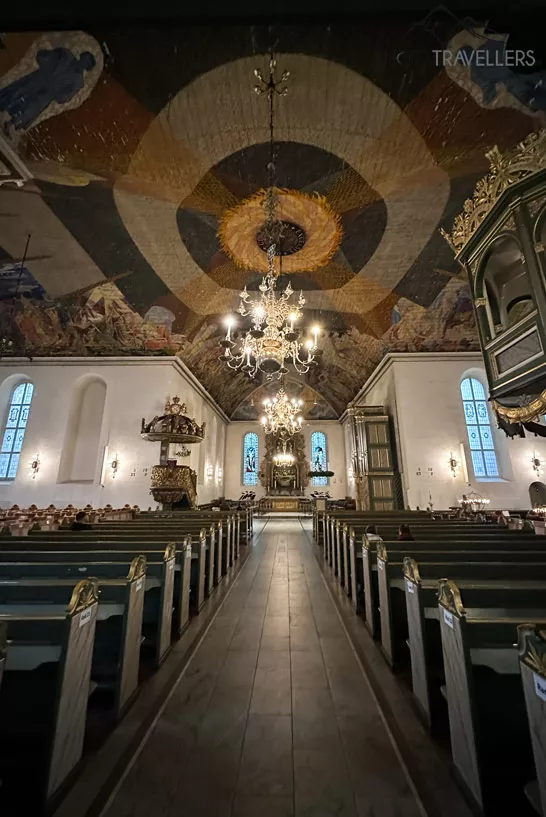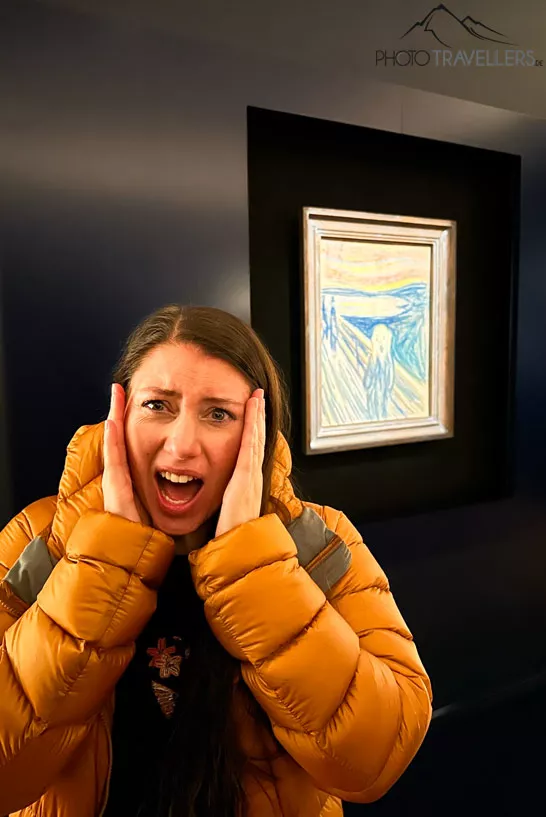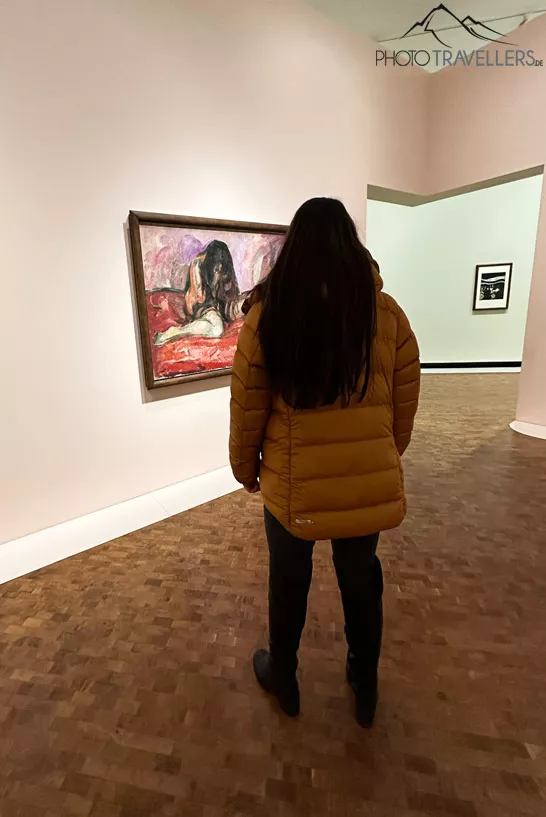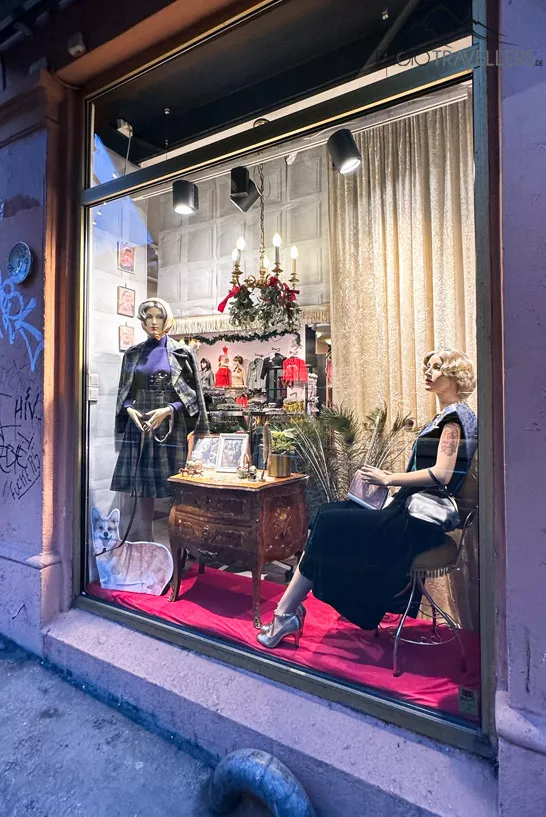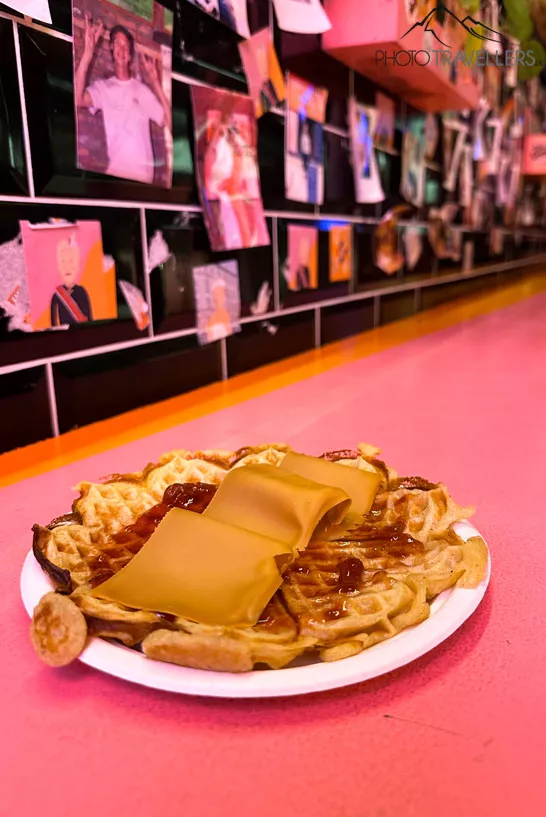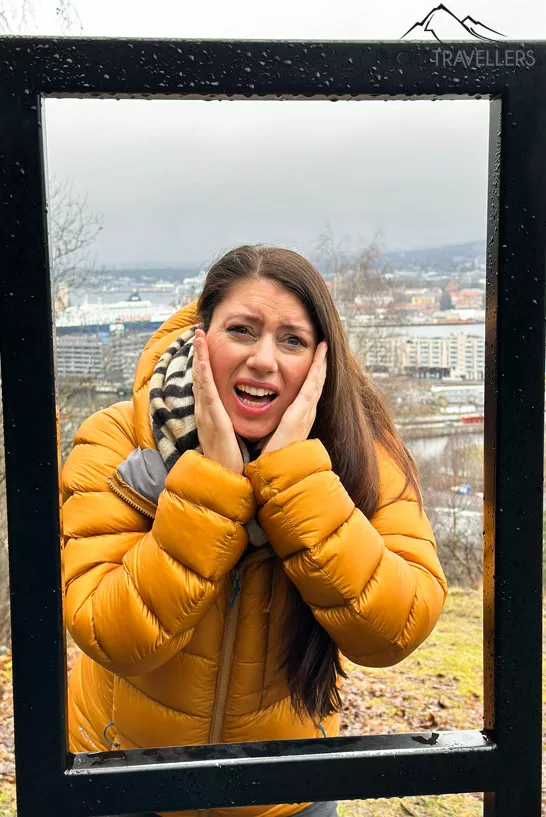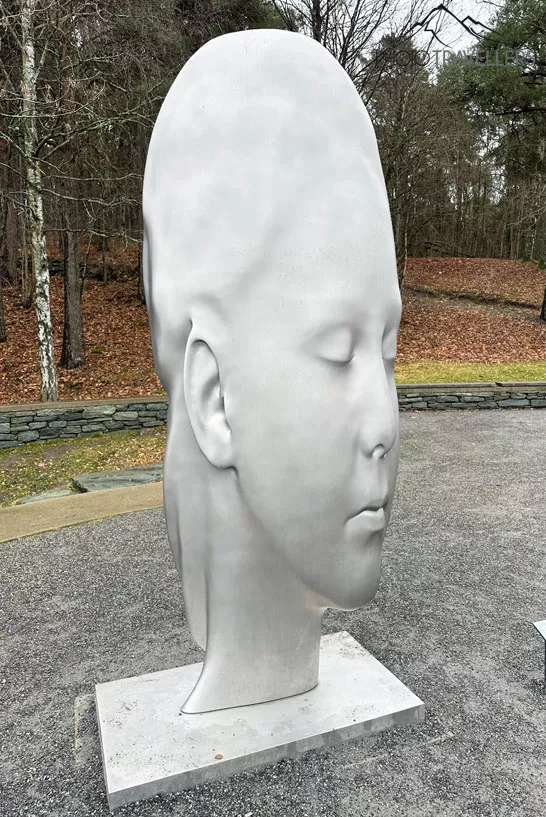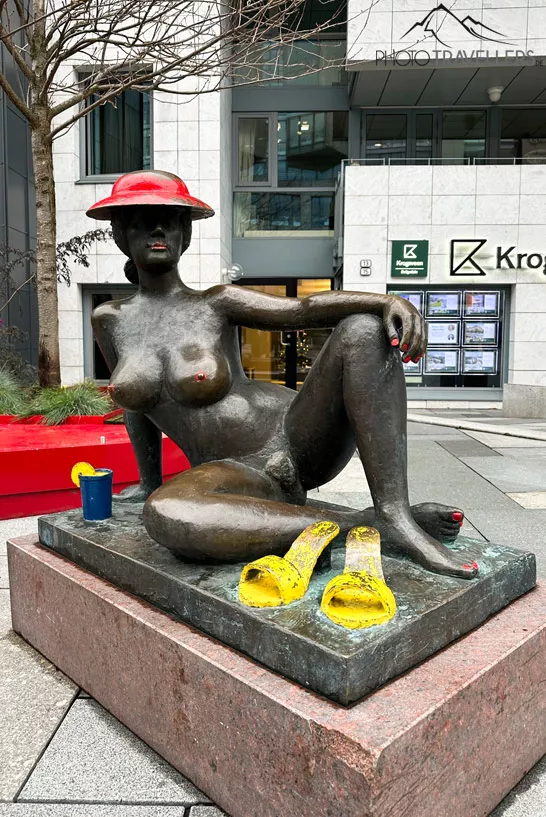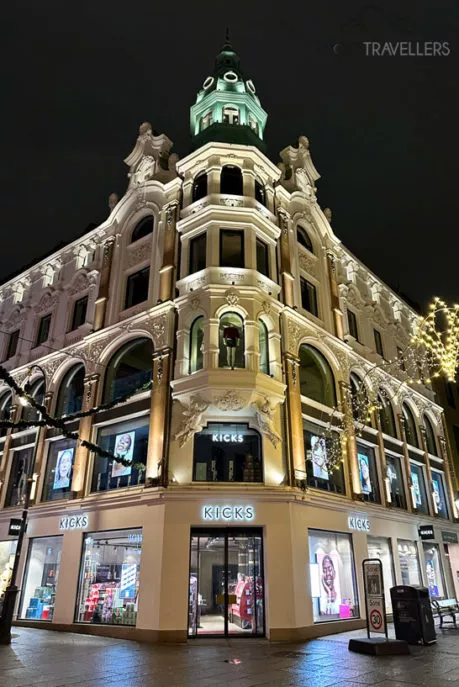
Things to do in Oslo: 20 beautiful places you must see [with map]
Oslo enchants with many beautiful attractions. It's worth taking a closer look at the capital of Norway - even if only on a short trip - and soaking up the creative flair of the northern metropolis.
We now take you on a city tour to the most beautiful sights in Oslo. Have fun with our travel tips.
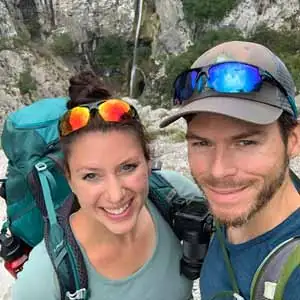
Hi! Wir sind Biggi & Flo
Wir nehmen dich als Reisejournalisten mit zu den schönsten Orten der Welt!
Werbehinweis: Alle mit einem * markierten Links sind Werbelinks.
The top 20 sights in Oslo at a glance
The capital of Norway is always worth a visit. Here you will find our top sights in Oslo, which you should not miss. Tip: Here we also tell you the most beautiful sights in Norway.
- Opera house Oslo
- Fortress Akershus
- Vigeland Sculpture Park
- Royal Castle
- Karl Johans Gate
- Parliament
- Oslo City Hall
- Oslo Cathedral
- Munch Museum
- Frogner district
- Fram Polar Ship Museum
- Grünerløkka district
- River Akerselva and Grafitti
- Holmenkollen ski museum & ski jump
- Insider tip: Ekebergparken
- Botanical Garden in Tøyen
- Grønland district
- Tjuvholmen
- Damstredet und Telthusbakken
- TusenFryd Amusement Park
Video: Oslo’s most beautiful attractions
1. The New Opera House
Our first sightseeing destination is the New Opera House, right next to the Central Station. The actual opera hall is surrounded by a glass structure that allows a view inside the building.
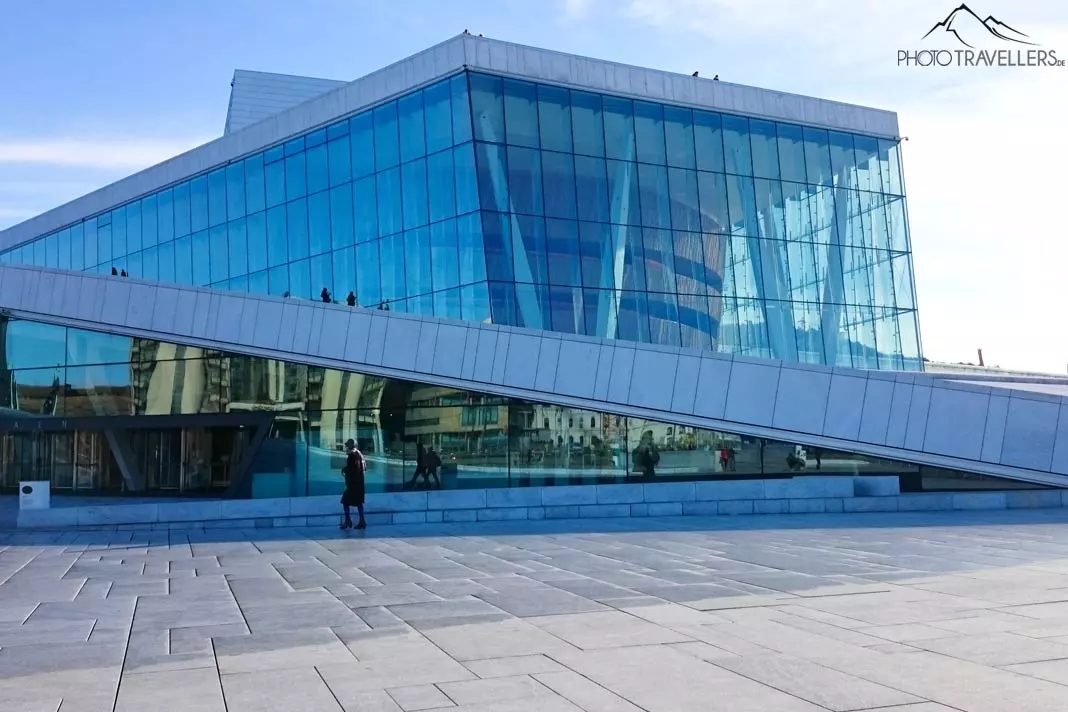
The opera house, which is modeled after a floating iceberg and opened in 2008, is located right on the water. If it weren’t so chilly in mid-February, you could linger in the sun on the shore for quite a while at this sight.
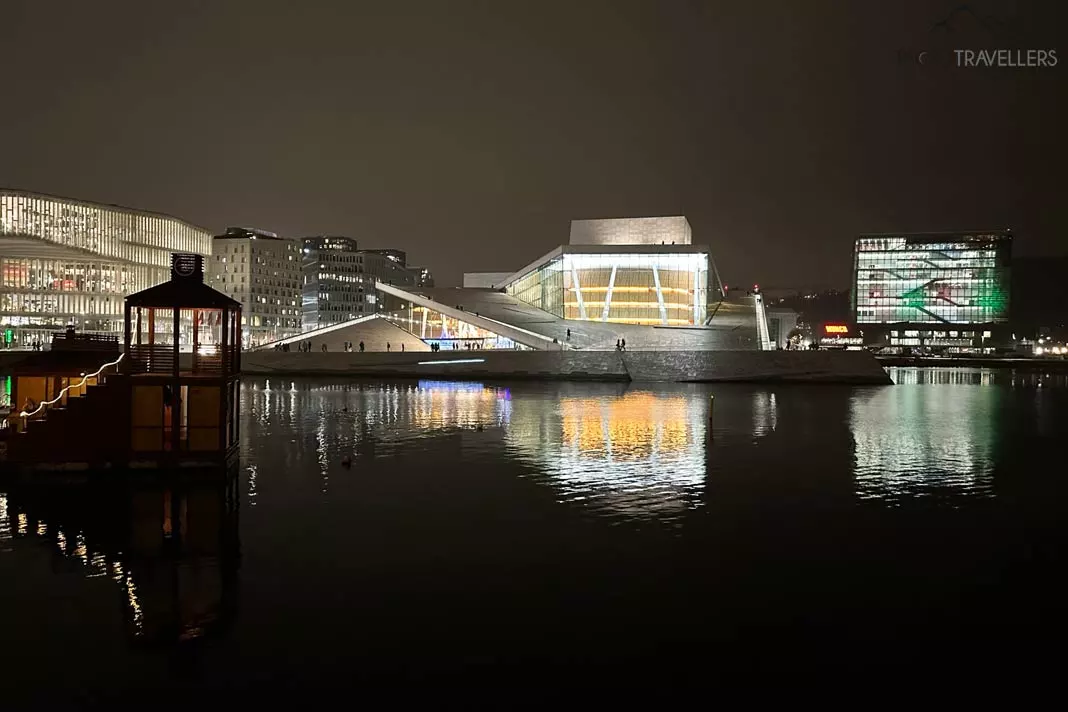
Be sure to go up to the roof of the opera house. Here you can enjoy a magnificent view of the Oslo Fjord. But you should also see the inside of the opera. If you don’t have time for an opera performance, at least take a look in the foyer. The design of the hall is worth seeing. By the way, in the main hall there is Norway’s largest chandelier.
The opera house is located in the Oslobukta district of Bjørvika. The Sørenga and Barcode neighborhoods, as well as the Opera House and Munch Brygge with the Munch Museum, provide Oslo residents with architecture, beach, art, and culture.
The Barcode neighborhood is directly adjacent to the Opera House. It’s called that because the houses look like barcodes, in black and white and arranged one after the other. The architecture is very impressive. Especially at night, it’s worth a detour. Here you also have a little New York feeling. In addition, we can recommend Barcode Street Food. Here you can find cheaper food from all over the world and many vegan options.
The end of the new hipster district is Sørenga. This is where you’ll find Oslo’s beach. A piled-up island stretches from Bispevika to the Oslofjord. The Sørenga Pier runs along the harbor basin overlooking the fjord. The fjord swimming pool is also located here.
Our hotel tips for Oslo
2. The Akershus Fortress
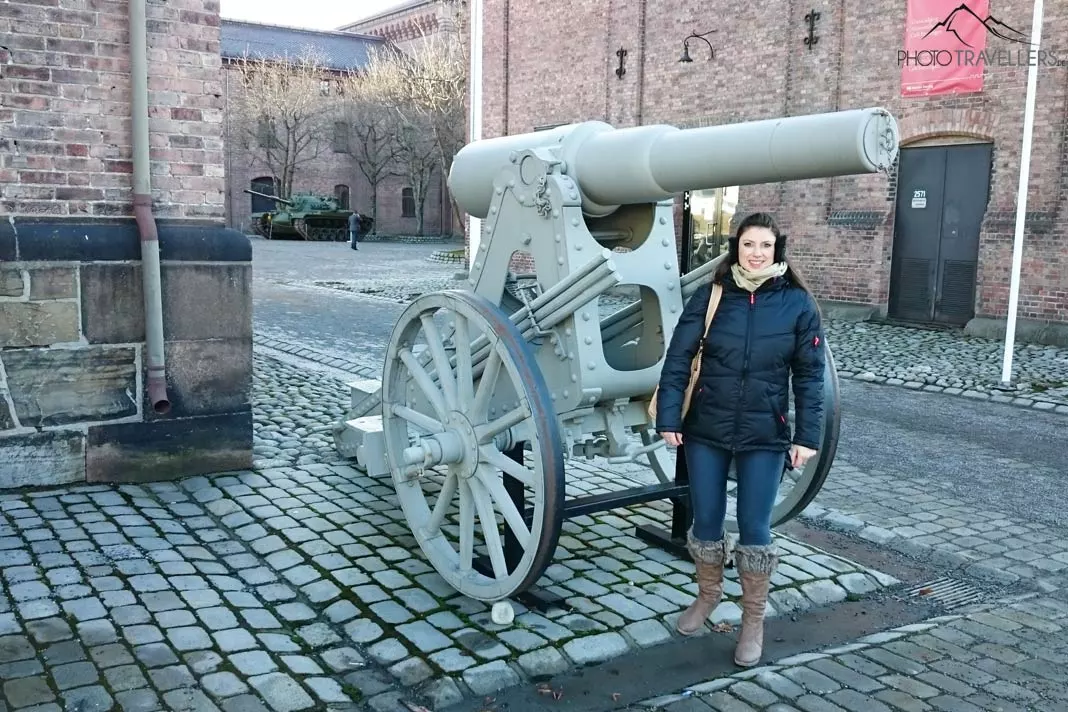
Our short trip through Oslo, for which we have only a couple of hours, takes us further to the Akershus Fortress in the heart of Oslo. The fortress is located on the shore of the Oslofjord and shapes the silhouette of the city quite significantly. It’s a cool thing to do and definitly worth a visit! Highlights are the old cannons and tanks, which make a great photo motif. To visit the fortress Akershus, we unfortunately lack the time. This is a real pity, because the fortress is really one of the top sights in Oslo.
If possible, really take the time to look at the fortress. When exactly the fortress was built is only roughly known – probably in the period between 1287 and 1300. Over the centuries, the fortress was besieged nine times.
During the Second World War, the fortress came under German control. Today, Akershus Fortress is still used by the military but also serves as a museum and recreational facility. In addition, the fortress houses the Royal Mausoleum, where Norwegian kings of modern times are buried.
3. The Vigeland Sculpture Park
Another beautiful place to go is the famous Vigeland Sculpture Park. In the park, there are 212 stone and bronze sculptures of the Norwegian sculptor Gustav Vigeland, which were created in the years from 1907 to 1942.
The figures might surprise one or the other. They also show older people, just life. Here we expect no god-like figures, but quite normal people marked by life. The park is open all year round. There is something going on here at any time of the year. The sculpture park is definitely a top photo spot in Oslo.
Our tip: There is a cute little café at the entrance. There are also public toilets here. They cost about 2 euros and you have to pay with a card.


We stroll through the park and discover exciting details again and again. The highlight is the “Monolitten,” a 17-meter-high column of 121 granite figures surrounded by 36 groups of figures.

If you’re into flea markets, then you should definitely check out the Vestkanttorvet flea market. It’s right around the corner from Vigelandsparken. It’s quite informal, the stalls are small, and you can find many a curiosity. But there is also a lot of vintage, homemade and much attention to detail.
Recommendable Oslo travel guide
If you’re planning a city trip to Oslo, it’s worth browsing travel guides beforehand. Here we show you the best travel guides for your city trip. You really should have a look at the Lonely Planet Pocket Oslo (get it here*) and to the famous travel guide of DK Eyewitness Norway (buy it here*).
4. The Royal Castle
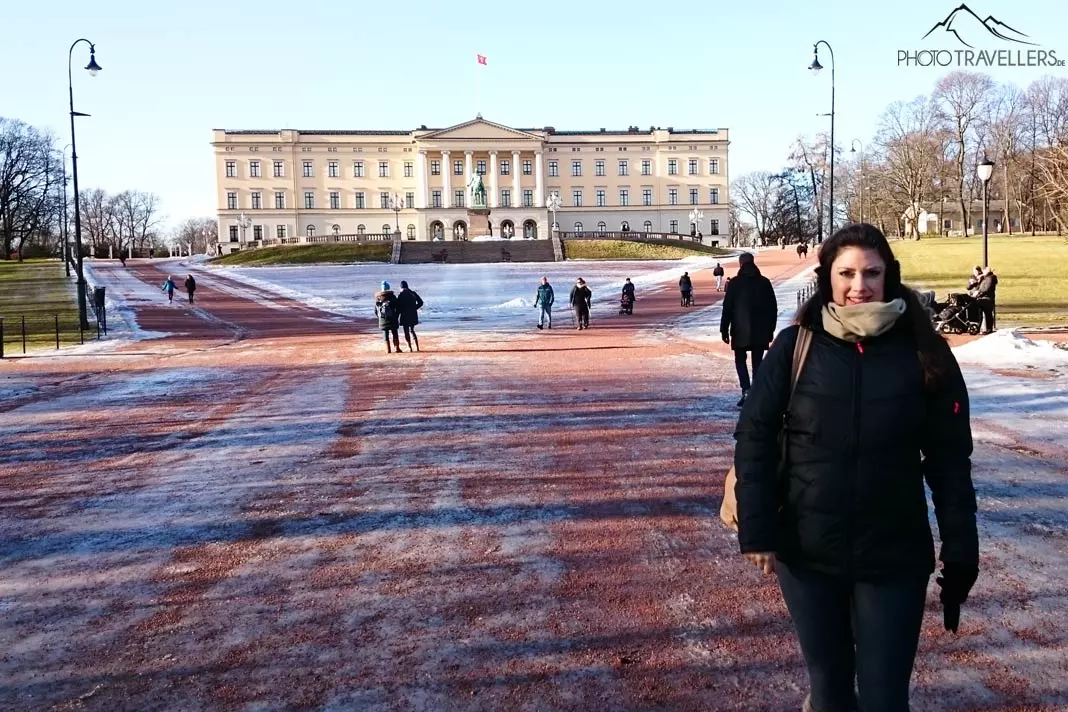
The next sight to see is the Royal Castle. Originally, it was a medieval castle with a royal residence. Between 1637 to 1648, the castle was rebuilt into a Renaissance castle. The changing of the guard takes place daily at 13:30. It’s an unusual thing to do!
Guided tours are also available from late June to mid-August. The tour lasts about one hour. Tickets are available at post offices in the city.
Great activities in Oslo
| Activity | Price | Ticket |
| Sea kayak course in Oslo | from 174 Euro | book it here* |
| 8 Zipline Canopy Tour over the Cetina River, Omis | from 54 Euro | book it here* |
| Cross country skiing courses for all levels near Oslo, Norway | from 216 Euro | book it here* |
| Oslo Fjord Sightseeing Cruise by Electric Boat | from 37 Euro | book it here* |
| Ticket for Paradox Museum | from 23 Euro | book it here* |
5. The famous shopping street Karl Johans Gate
Another important sight is Karl Johans Gate, or Karl Johan for short. It’s the main boulevard in Oslo. At Christmas time it’s beautifully decorated with huge bells. The light poles look like they used to in the golden 1920s.
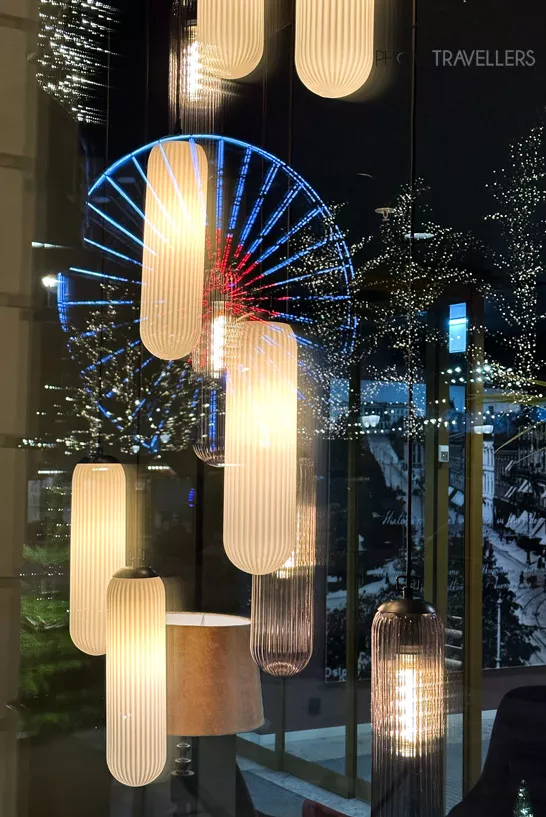
The street is not only the main shopping street, but also a popular meeting place. It stretches from the Central Station to the Royal Palace.
Karl Johans Gate is also home to the National Theater and the Spikersuppa ice skating rink, where you can skate from December to March. Also, around the skating rink is the Oslo Christmas Market with the famous tunnel of lights and the Ferris wheel.
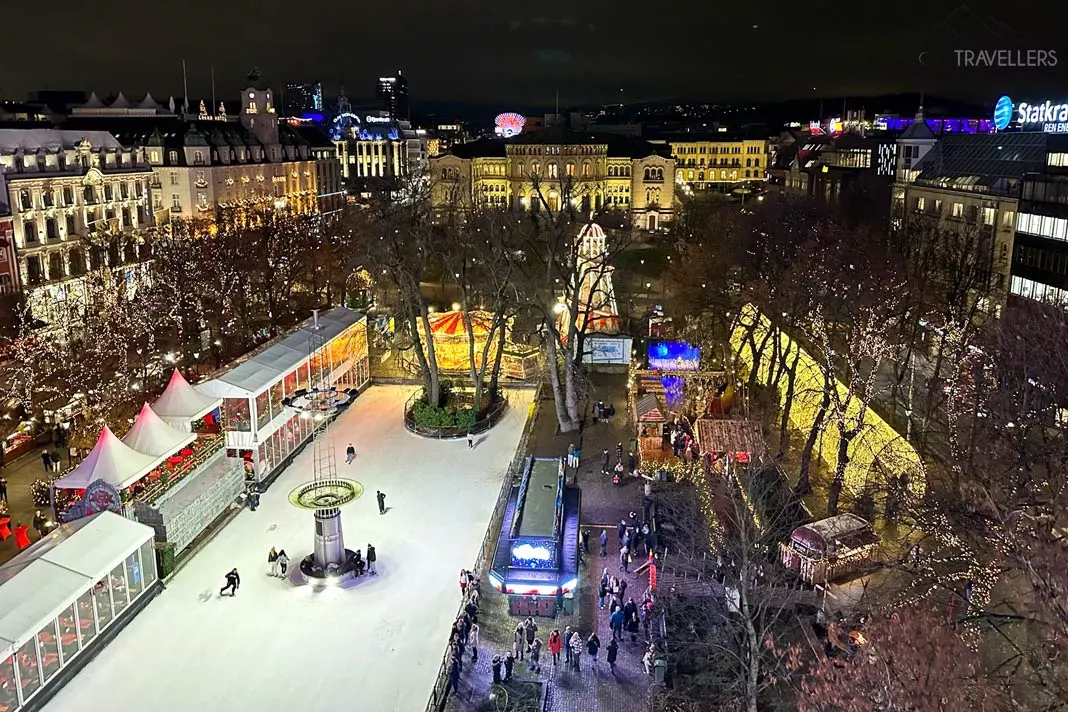
Our dining tip near Karl Johan Gate: Nordvegan. Here you can get delicious vegan food at a good price.
6. The Parliament
The Parliament building (Stortinget) is also one of the top things to do in Oslo. The building was built in 1866 and is the seat of the Norwegian National Assembly. There are even free guided tours of the parliament. Even from the outside, the building is very imposing. It is not for nothing that it is one of the most famous sights of the city.
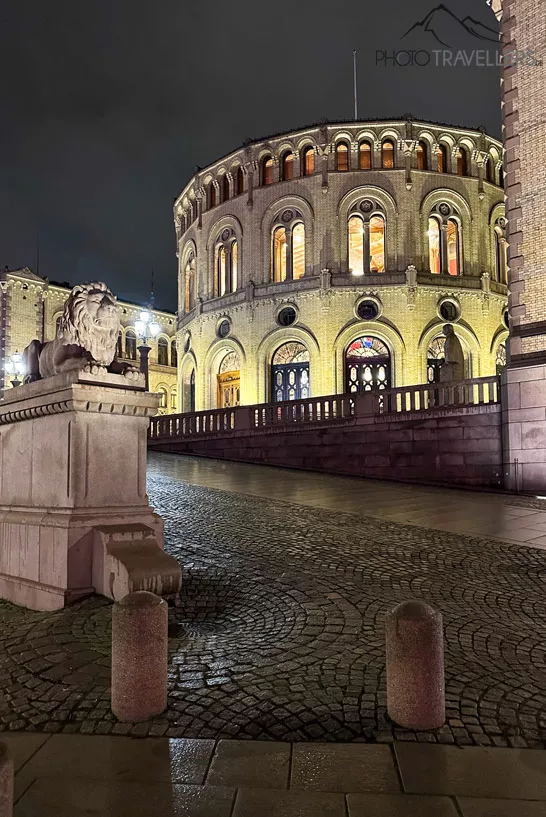
Even from the outside, the building is very imposing. It’s not for nothing that it’s one of the most famous sights of the city.
Opposite the parliament is the National Theater of Oslo. It has existed since 1899 and is the largest spoken theater in Norway. Around the building, there are many statues. Opposite the theater is the very nostalgic Theatercaféen (Google Maps).
7. Oslo City Hall
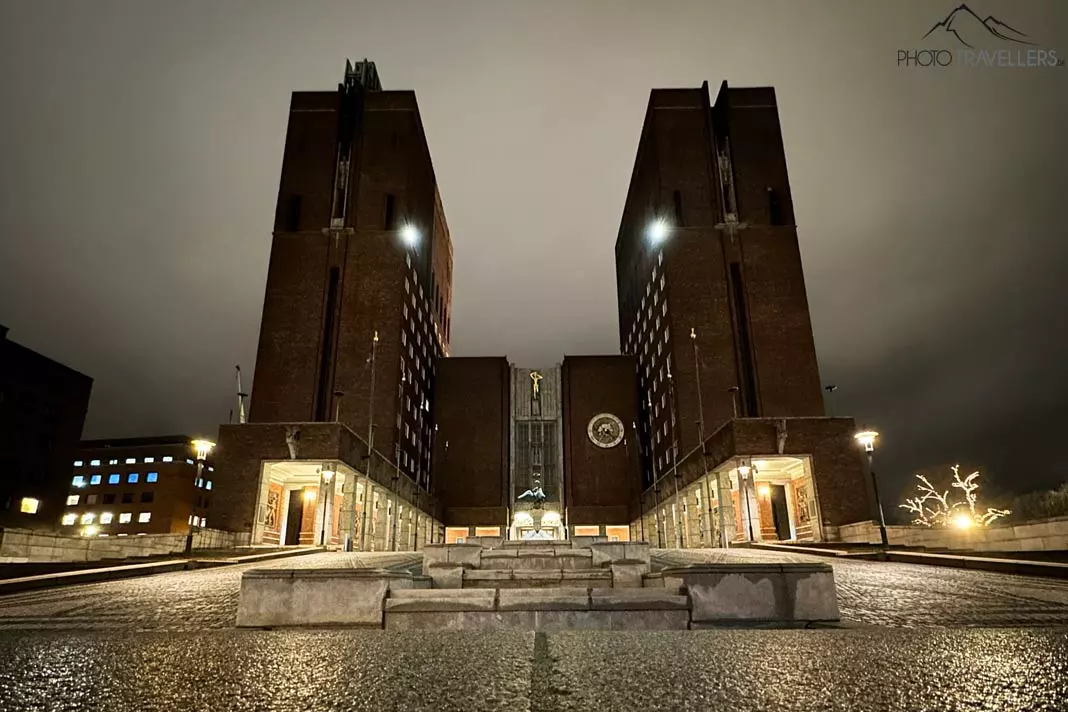
From far away we can hear the chimes of the city hall tower. 49 bronze bells are ringing and attract our attention. At first glance, Oslo’s City Hall seems downright monstrous. No wonder: At that time – the construction started in 1931 – the city hall was supposed to symbolize the newly acquired independence of Norway.
The astronomical clock at the main entrance immediately catches the eye. But the porticoes are also remarkable. Norwegian mythology is explained here. Odin and Thor experience many adventures in pictures. We spent some time here looking at the various art compositions.
The Oslo City Hall is also where the Nobel Peace Prize is awarded every year. Directly on the fjord near the City Hall are the Nobel Peace Center and the National Museum.
Tip: Not far from the City Hall is the Post Halls (Google Maps). A former huge post office building was converted and opened into a bar area. You order via app – as usual – and then pick up your drink at the respective bar. The design, the furnishings, everything makes for a great experience and a nice evening.
8. Oslo Cathedral
Another important sight is the Oslo Cathedral. It’s the largest church in the city. It was built from 1694 and the architecture was designed by an architect from Germany. Some parts of the church are still original from the construction at that time, such as the pulpit, the altar panel and the organ facade .
We were especially impressed by the ceiling painting. It is huge. They were made by the artist Hugo Lous Mohr. The stained glass windows were designed by the brother of Gustav Vigeland (Vigelandparken).
Right next to the cathedral is also the oldest department store in the city. GlasMagasinet Stortorvet is a traditional department store located on Stortorvet Square. The department store has existed since 1739.
9. The impressive Munch Museum
Right by the Opera, on Munch Brygge, is the new Munch Museum (Google Maps). It’s dedicated to just one artist, Edvard Munch. The museum is one of the world’s largest museums dedicated to just one artist. Here you can extensively admire Munch’s legacy to the city of Oslo.
The highlight is the famous painting “The Scream“, which exists in several variations, but only one of which is ever shown.
Tip: At the very top of the Munch Museum is a great skybar, the Munch Skybar, with great views of the Oslo Fjord. If you’re on a tight budget, go one floor below the Skybar. Here you also have a great view of the fjord, but you don’t have to pay for a drink.
10. The beautiful Frogner district
The next sight in Oslo will definitely impress you! Glamorous – that’s how you can describe the Frogner district. Here we discovered the nostalgic Frogner cinema. In the café next to it you’ll find delicious popcorn. But also otherwise the café is worth a visit. What we found terrific: Here you can also invite other people for a coffee, they are happy.

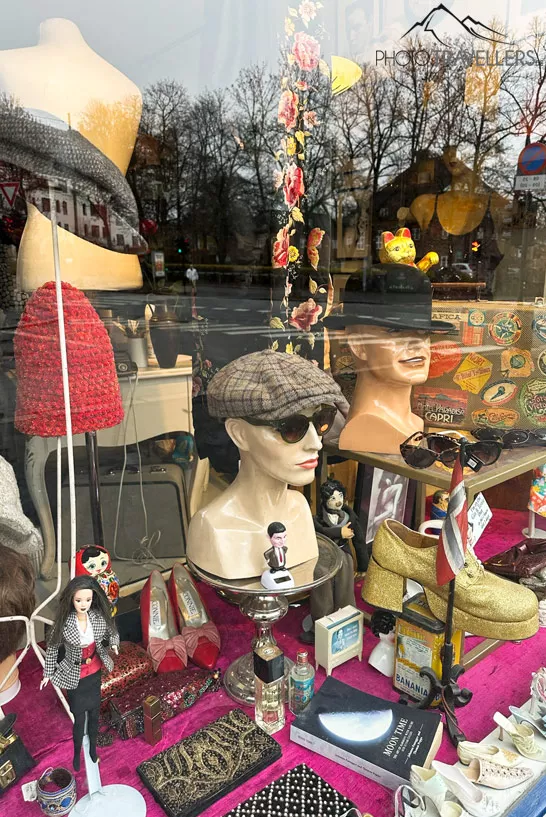
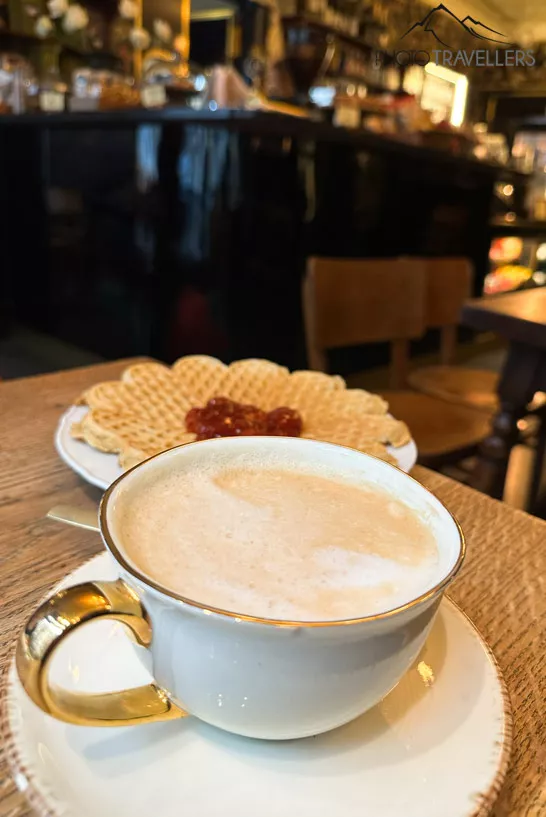
Around the corner are many vintage stores. Oslo is very creative when it comes to these small stores. You should also take a look at the house facades from the 19th century during a side trip.
The Frogner district also includes the museum island Bygdoy. Here you will find – as the name suggests – various exciting museums. The nature on the island is also very beautiful. In summer, the natural beaches are very popular.
Our tip: The Kon-Tiki Museum is all about the exciting expeditions of Thor Heyerdahl (Wikipedia). The adventurer sailed with his team with a raft made of balsa wood from Peru across the Pacific to Polynesia around 1947.
11. Fram Polar Ship Museum
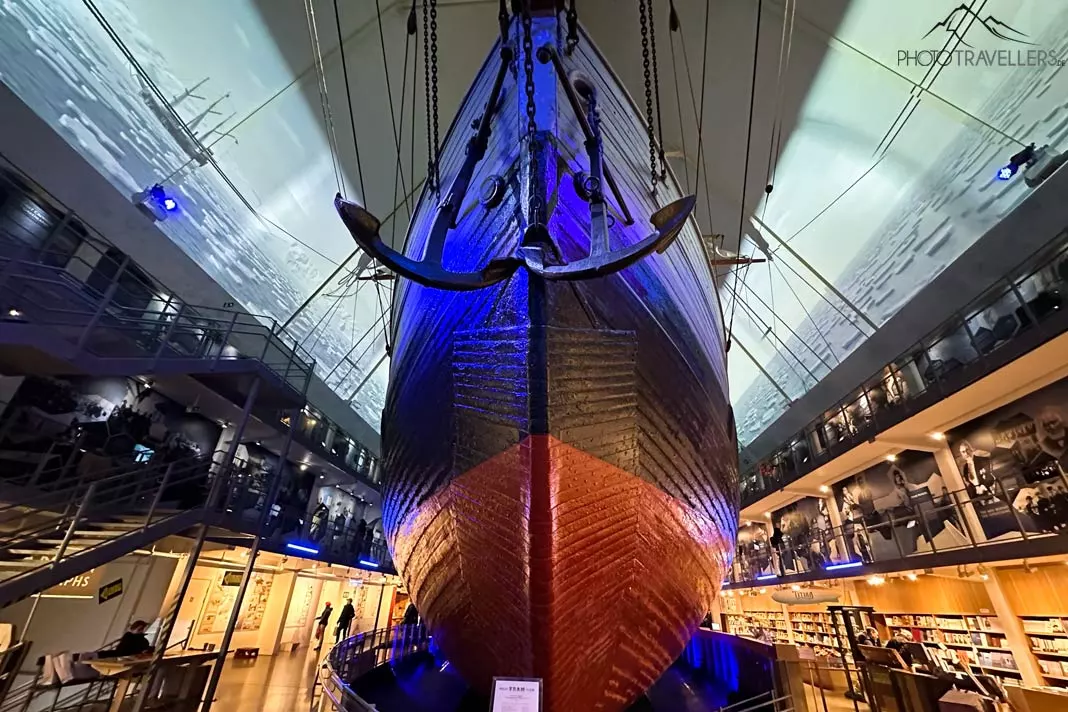
The Fram (Frammuseet in Norwegian) Polar Ship Museum (Google Maps) is an absolute superlative in the Norwegian capital. Fram is about a ship. It is the strongest ship in the world, which was also built of wood. A visit here is a fun activity to do!
It was used in polar expeditions. The explorers Fridtjof Nansen, Otto Sverdrup, and Roald Amundsen were traveling with it. The huge ship was built in 1892. Today you can visit it, including the interior.
The museum is called the Polar Ship Museum because everything here is about polar history. There are also changing exhibitions. A visit here is a great thing to do!
The museum is suitable for families as well as people interested in polar expeditions. In total, you should allow at least 2 hours during your visit.
You can reach the museum from the city center by bus no. 30. The entrance fee is about 11 euros (120 NOK). There is a combination ticket for the Fram Polar Ship Museum, Kon-Tiki Museum (Kon-Tiki-Museet), and the Norwegian Maritime Museum (Norsk Maritimt Museum). The three museums are located close to each other.
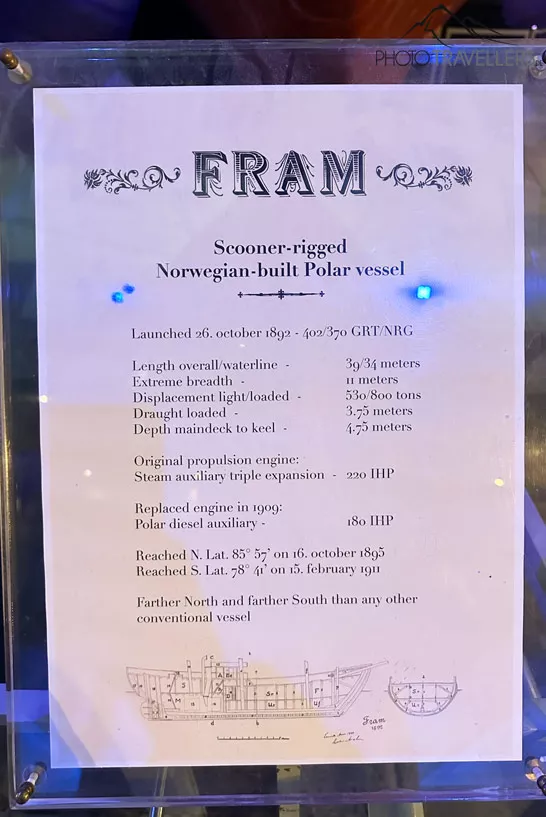
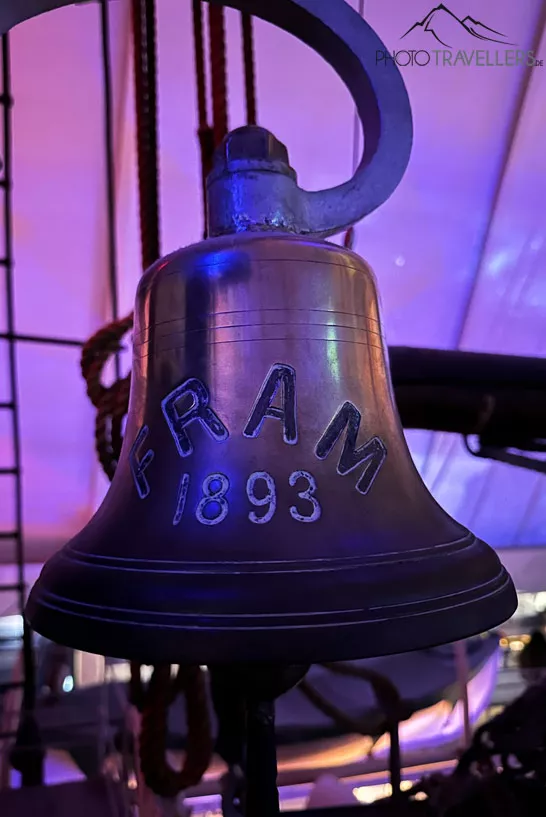
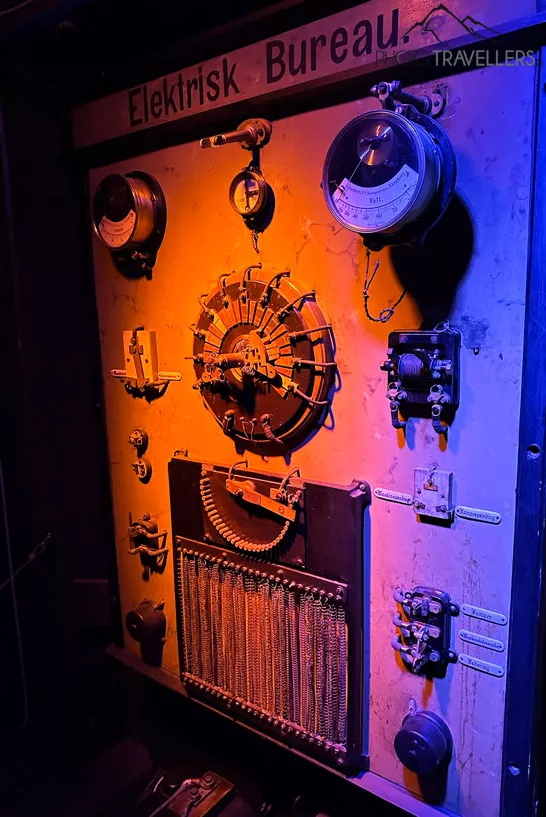
The museum is suitable for both families and people interested in polar expeditions. In total, you should allow at least two hours during your visit. The interior of the ship alone will impress you.
You can reach the museum from the city center by bus line 30. The entrance fee is about 11 euros (120 NOK). There is a combination ticket for the Fram Polar Ship Museum, the Kon-Tiki Museum (Kon-Tiki-Museet) and the Norwegian Maritime Museum (Norsk Maritimt Museum). The three museums are located close to each other. But the Vikingskipshuset is also very popular.
12. The Grünerløkka district
The next Oslo sight you should definitely explore on foot. The two main streets in the in district Grünerløkka are Markveien and Thorvald Meyers Gate. Here you should definitely go for a stroll and really immerse yourself in the district.
The selection of stores, vintage stores and other special displays is huge. We were totally fascinated. In one store, the nostalgic sewing machine was still rattling. And in the other, Queen speeches were played loudly on the street. The scene here is very creative and a little bit crazy.
Our tip: Be sure to stop by Harald’s Vaffel. This little waffle snack has been around forever. We had the typical waffle with the brown goat cheese. But you should also check out the coffee roasters in Norway. Norwegians love good coffee. And you can get it at the Kaffebrenneriet.
Nightlife tips for Grünerløkka
The nightlife in Grünerlokka is fantastic. We are drawn to the fascinating Aku-Aku Tiki Bar. It’s a tribute to the famous explorer Thor Heyerdahl. The bar has a boat hanging from the ceiling. The cocktails are fancy and really tasty. Bar Chair also offers a great interior design and a huge selection of gin with advice. You can find cheaper food from all over the world at Oslo Street Food. The Kulturhuset (Google Maps) is a great place to go out. On different levels you can chill out like in a living room, party with a DJ or play shuffle board.
Our tip: Take a detour to the Mathallen Oslo. They are already celebrating their 10th anniversary in 2022. That’s how long you can visit the market halls and feast in the city.
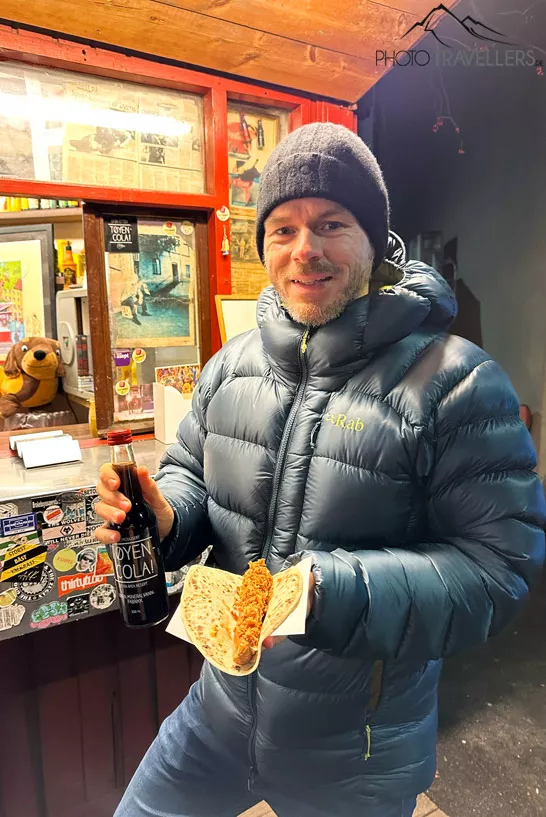
And very important: In Grünerløkka you will also find one of the last hotdog stands in town: Syverkiosken (Google Maps). Here, in the little house there are veggie hot dogs for us.
13. River Akerselva and Brenneriveien
The Akerselva River winds its way through the whole of Oslo. It has its source in the lake Maridalsvannet. By the way, this is Oslo’s largest lake. If you want, you can walk along the river for about 8 kilometers from here.
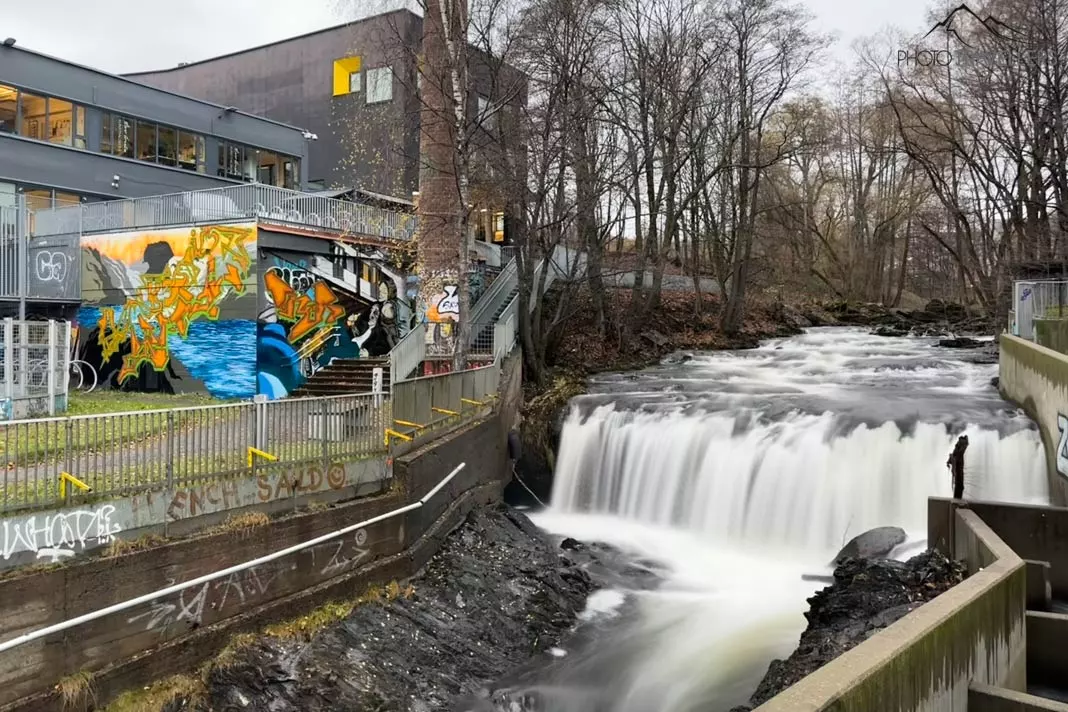
In the 19th century, the river was the supply for the entire industry. From sawmills, textile factories as well as mechanical workshops. Today the river is an important recreational area of the city.
A visit to Oslo’s green lung is a great thing to do. Or rent a kayak and explore the river from a whole new perspective.
Here by the river – we are still in Grünerløkka – the alternative art scene is active. Also, Oslo’s graffiti scene started here in this neighborhood in the 90s. Be sure to check out this street Brenneriveien.
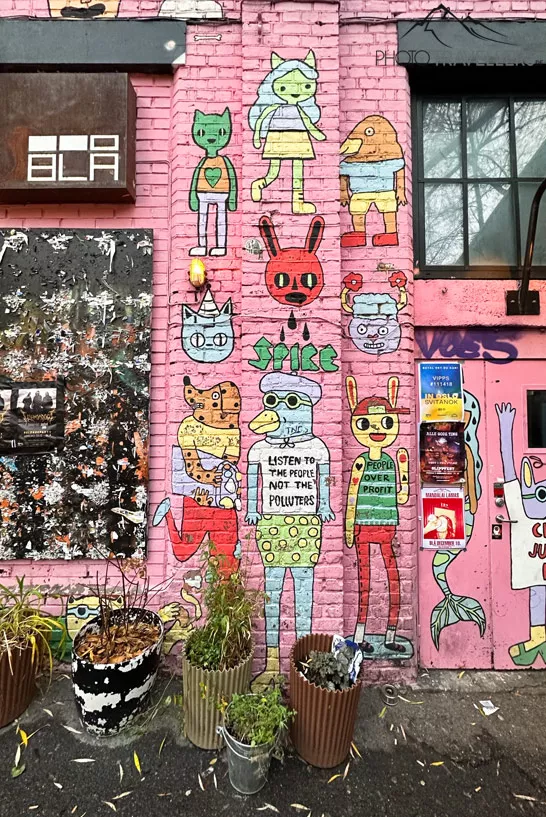
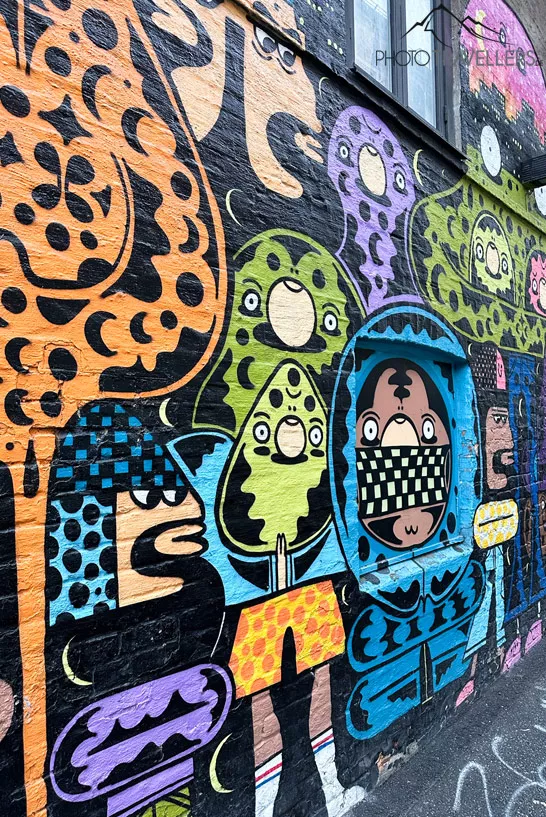
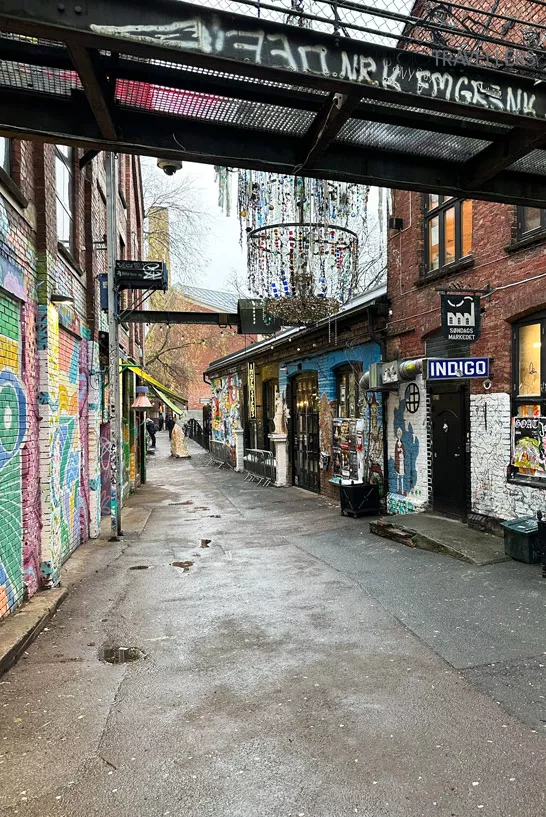
You’ll see right away: brick buildings, possibly old factory buildings that are now used as galleries. You should definitely take your camera with you to this area. Otherwise you will miss the swan penis and other bizarre installations.
14. Holmenkollen Ski Museum & Ski Jump
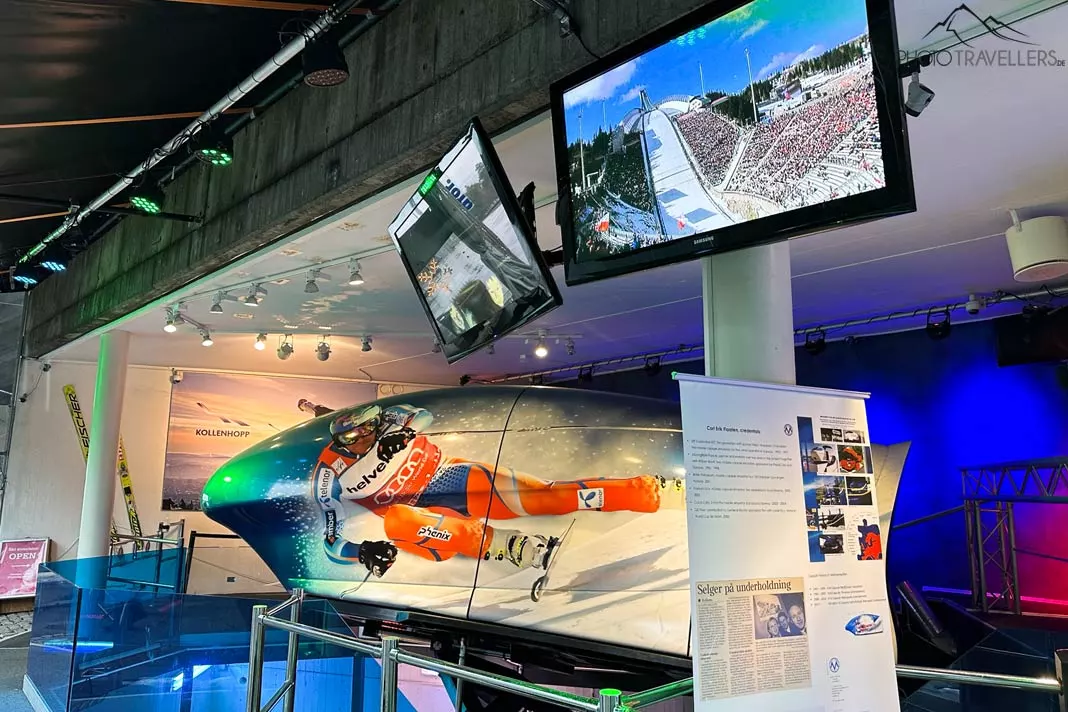 Holmenkollen Ski Museum even has a ski flight simulator
Holmenkollen Ski Museum even has a ski flight simulator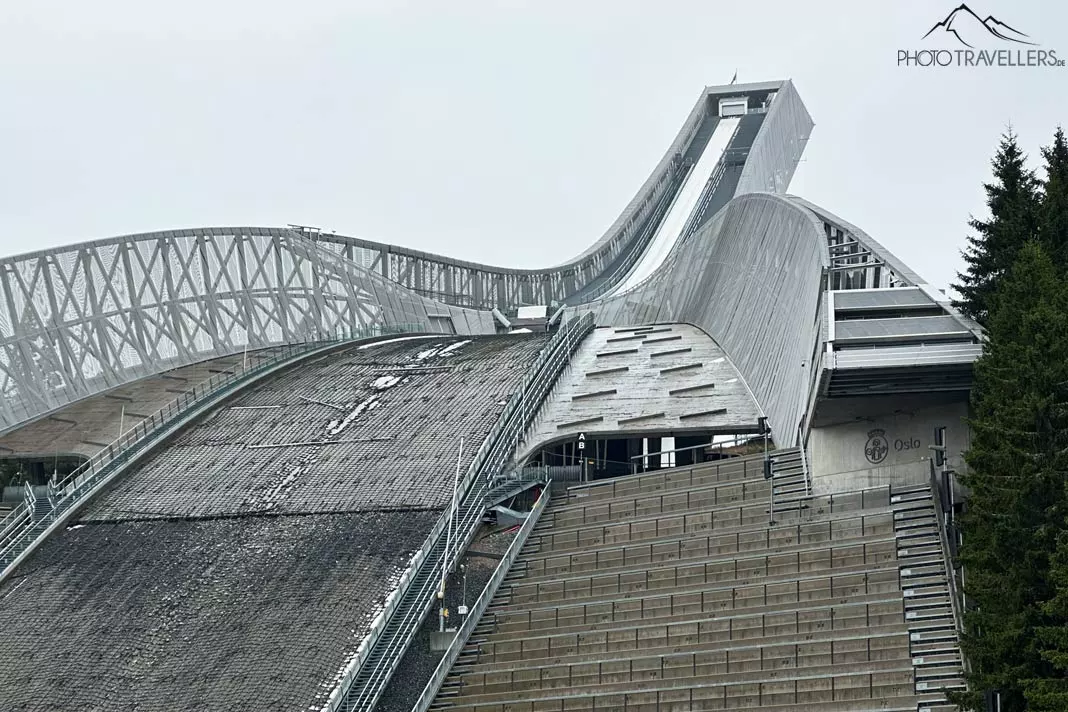 Holmenkollbakken ski jump is one of the most famous Oslo attractions
Holmenkollbakken ski jump is one of the most famous Oslo attractionsHolmenkollen Ski Museum & Ski Jump is the oldest ski museum in the world, making it a very cool thing to do in Oslo. Here you will experience the 4000-year history of skiing in Norway.
The huge ski jump is visible from far away. From the ski jump tower, you have a great view of Oslo. What else is in the Museum to do? If you want to recreate the experience of ski jumping, there is even a flight simulator- a very fun thing to do!
There is also a frisbee golf course, a flying fox, and you can even abseil from the tower.
Admission costs about 14 euros (150 NOK) for adults. Address: Kongeveien 5 (Google Maps)
15. Insider tip: Ekebergparken
If you want to escape the city hustle and bustle for a bit, we can recommend Ekebergparken Sculpture Park (Google Maps). The park was created with many figures. Already about 100 years ago, the park served the workers of Oslo’s southern suburbs for recreation. And even today, this green lung is perfect to unwind.
From the streetcar stop Oslo Hospital we walk into the park. We immediately walk to a viewpoint where Edvard Munch’s painting “The Scream” could have been taken. Anyway, you can recreate the painting here with a view of the Oslo Fjord. The viewpoint is called Geitespranget.
The figures in Ekebergparken are more than special and scattered throughout the park. We were very impressed by some of them, such as the huge art installation at the viewpoint by Ekebergrestauranten. From up here you also have a great view of the city and its illuminated houses at night.
16. The Botanical Garden in Tøyen
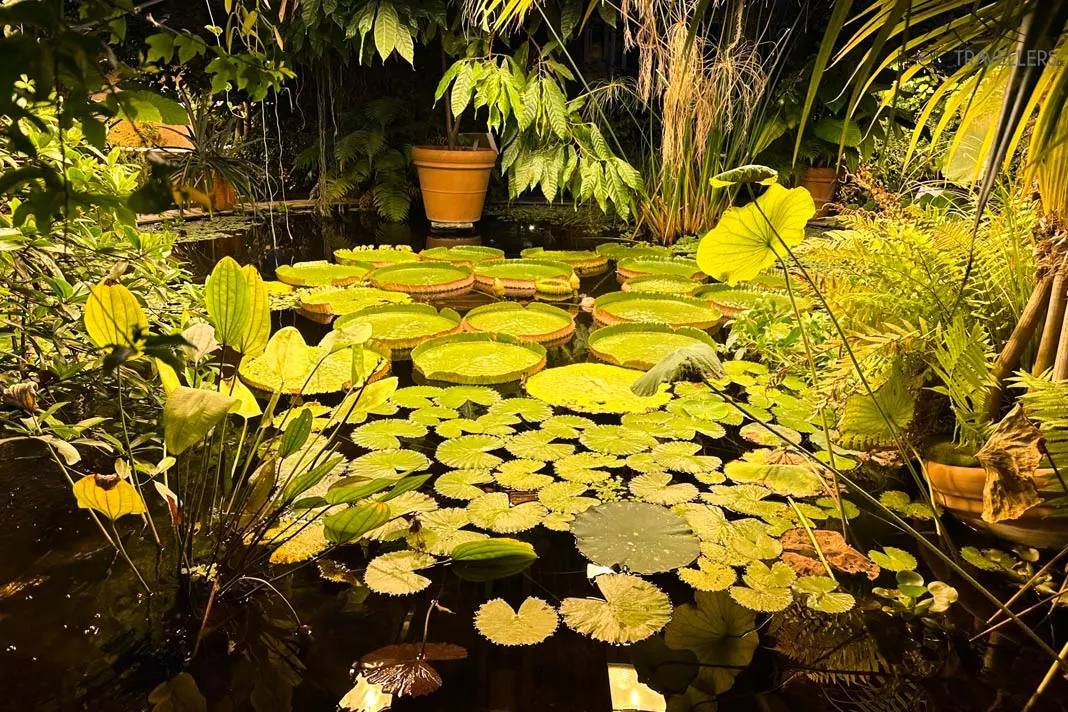
One of the special features in Oslo is the Botanical Garden. It’s located in the Tøyen district. It’s the oldest botanical garden in Norway. The palm house and the adjacent tropical house are very nostalgic and have a great flair. You don’t have to pay an entrance fee for this one. The grounds are huge and perfect for a picnic in the summer.
The Botanical Garden is also adjacent to the Naturhistorisk Museum, the Natural History Museum.
Above all, the street art in the multicultural district of Tøyen is outstanding. Here you will find huge walls of houses decorated with true art. Be it a giant purple cat smiling at you or even a giant Edward Munch. The city’s plan is to make the district Scandinavia’s largest open-air gallery.
By the way, the district has its own cola, Toyen Cola. The old Munch Museum is also located in this corner.
17. The district of Grønland
Grønland is not yet an in district, but will be soon. The conditions are definitely there. You can get to the district by subway or bus. You can also walk to Grønland from the Barcode district via Acrobats Bru, a very stylish bridge.
We drifted past the multicultural restaurants and felt a bit like we were in Berlin, in the Kreuzberg or Neukölln district.
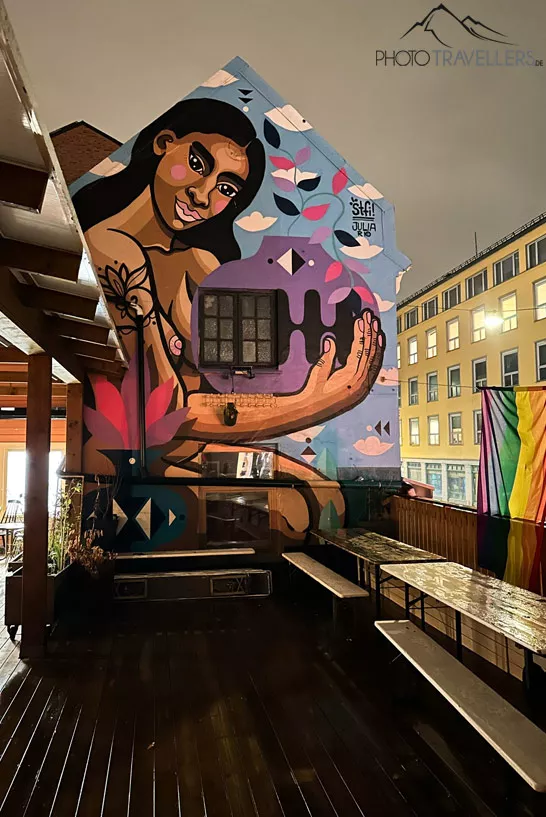
Our tip: Check out the bar Godthåb Bar & Café (Google Maps). Here you get delicious drinks in a great atmosphere with good music. DJs play here.
18. Aker Brygge with the peninsula Tjuvholmen
The district Aker Brygge with the adjacent peninsula Tjuvholmen should not be missed on your trip to Oslo. This sight is characterized by art and galleries. But also very fine fish restaurants provide a nice evening program. In addition to modern architecture, one art installation follows the next. It’s really impressive how many artists exhibit on the peninsula. Graffiti is also visibly represented here. We were very impressed by Tjuvholmen.
At Olav Selvaags Plass there is a pop-up store for the Christmas season. The island Tjuvholmen recreated from gingerbread. In addition, there are super delicious cup cakes. It’s worth strolling from gallery to gallery.
Tip: On the peninsula Tjuvholmen is also the design hotel Thief. Make sure to take a detour inside. The Astrup Fearnley Museum of Modern Art is also worth a visit.
19. The streets Damstredet and Telthusbakken
If you’ve had enough of the city and would rather immerse yourself in typical Norway, then off you go to Damstredet.
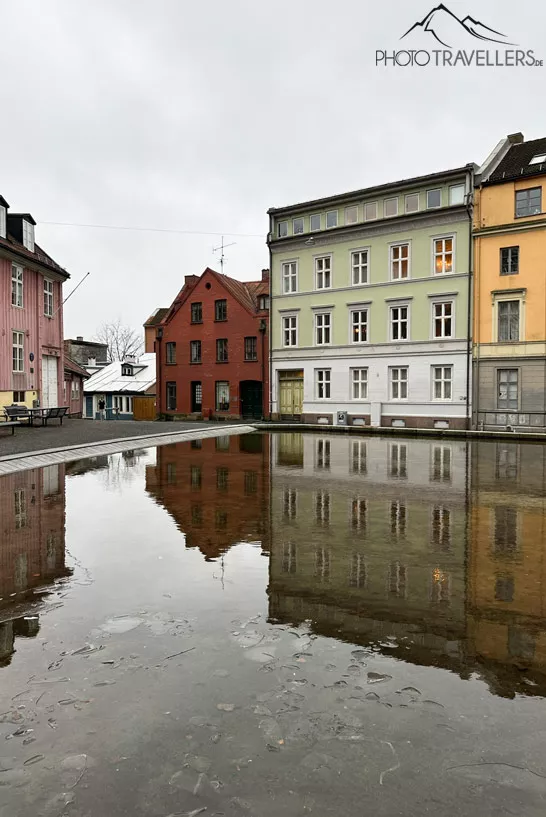
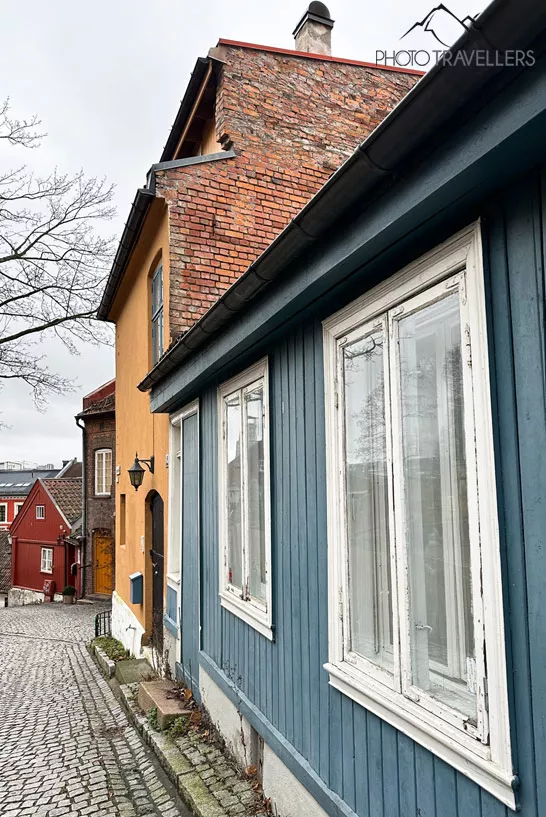
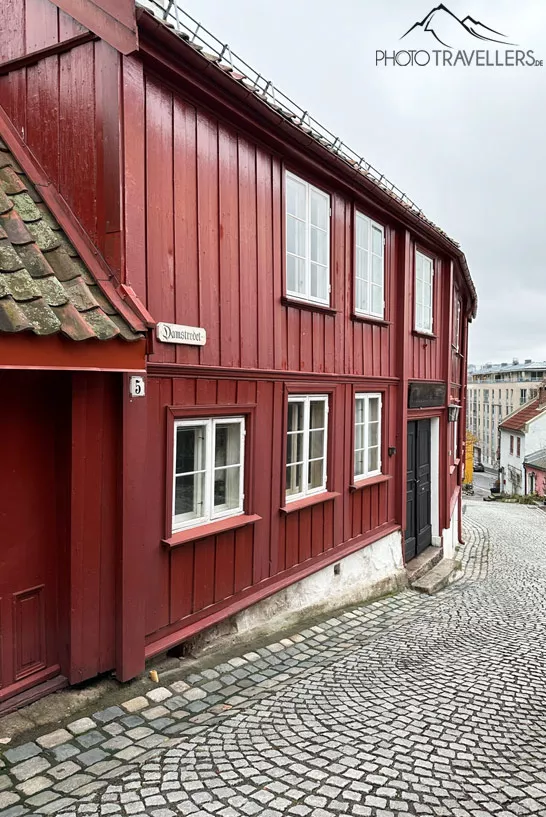
Here, in the middle of the city, the typical rural Norwegian houses with colorful facades suddenly await you. Everything looks like a small village. But you’re standing in the middle of Oslo. Crazy, isn’t it? The beautiful Christmas lights in the small street create a very special flair.
We can also recommend Telthusbakken. Here you will also find cute little houses.
Be sure to make a detour to the cemetery Vår Frelsers Gravlund. Here you will find many graves of famous people. Among others, Edvard Munch is buried here.
20. TusenFryd Amusement Park
TusenFryd Amusement Park (Google Maps) is the largest in all of Norway. If you are into carousels, roller coasters, or even the BadeFryd water park, then this is the best place to go.
The SpeedMonster roller coaster, for example, accelerates from 0 to 90 in two seconds. The park is open from May to October. The water park only opens in the summer months.
No wonder the name of this top thing to do in Oslo translates roughly as Thousand Joys Amusement Park. Families will also find plenty to do here in Norway.
Wellness tip: Son Spa
If you want to relax a bit and enjoy nature, we recommend a night or two at Son Spa, located just about 50 minutes south of Oslo (book here*).
At Son Spa, you’ll find a great spa area with a large pool and saunas. The highlight is the floating outdoor sauna on the Oslofjord. Even in winter, the brave jump into the ice-cold seawater after a sauna session.
Olsenbande: Film tip for Oslo fans
Older generations are certainly familiar with the Olsen Gang. In the films, the petty criminals Egon, Benny and Kjell are always up to something crooked in and around Oslo. If you’re into the fun and games, you’ll love the Olsen Gang films (shot between 1968 and 1998).
Excursion tips & activities
- Vettakollen: You’ll get a particularly nice view of the area around the city from Vettakollen (Google Maps). The Vettakollen is a small hill between the ski jump Holmenkollen and the lake Sognsvann. The spot is very popular because you can walk there just a few minutes from the metro station. It’s one of the easiest hikes in the forests around Oslo. The view is one of the top sights in the city.
- Ice rink SNØ: here you can go skiing, ice climbing and cross-country skiing 365 days a year.
- Kayaking on Lake Sværsvann: With the provider Wild Oslo we went kayaking, landed at an island, and roasted (veggie) sausages over the fire. The lake is about 25 minutes from Oslo by car.
- Holmenkollen Hike: We went hiking around the Holmenkollen ski jump with the provider Oslo Hiking. The tour is 5 kilometers long and offers beautiful views.
- Drøbak: it’s always Christmas in this charming little town, thanks to the Christmas house. The mail for the Christmas market arrives here.
- Hvaler Islands: this natural idyll is a two-hour drive from Oslo. But it’s worth exploring the beaches and taking a boat tour.
- Fredrikstad: check out Northern Europe’s best-preserved fortress complex. The town is enchantingly beautiful, especially at Christmas time.
- Kistefos Museum and Sculpture Park
- Hadeland Glassverk: in a show hall you can watch the glassmakers at work. In the cute wooden houses around you can find great glasswork in the factory outlet.
- Søsterkirkene in Granavollen
- Region Sjusjøen: located at the lake of the same name, 350 kilometers of slopes provide maximum cross-country skiing fun. We stayed here in a self-catering cabin. That was very romantic.
- Lillehammer: Even though the town is more than two hours away from Oslo, it’s worth a trip to the Maihaugen open-air museum, the Olympic Museum and, in winter, the Lillehammer World Cup. The city itself is also very beautiful.
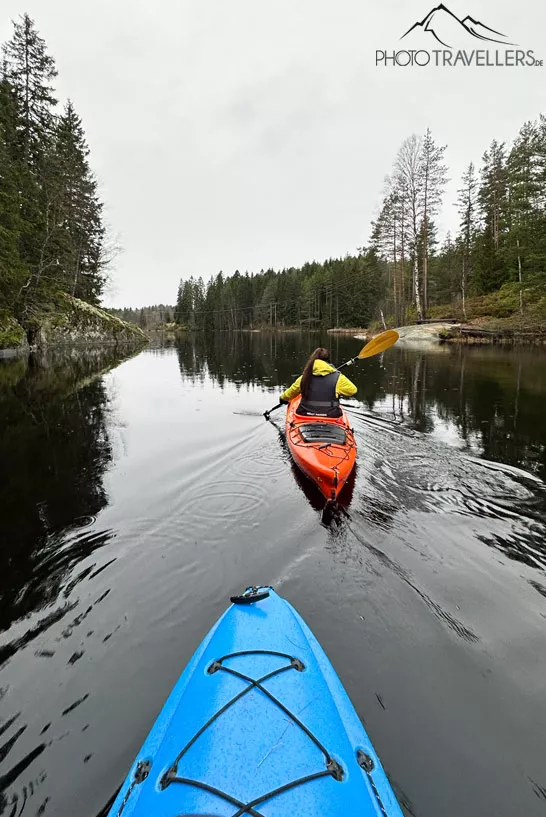
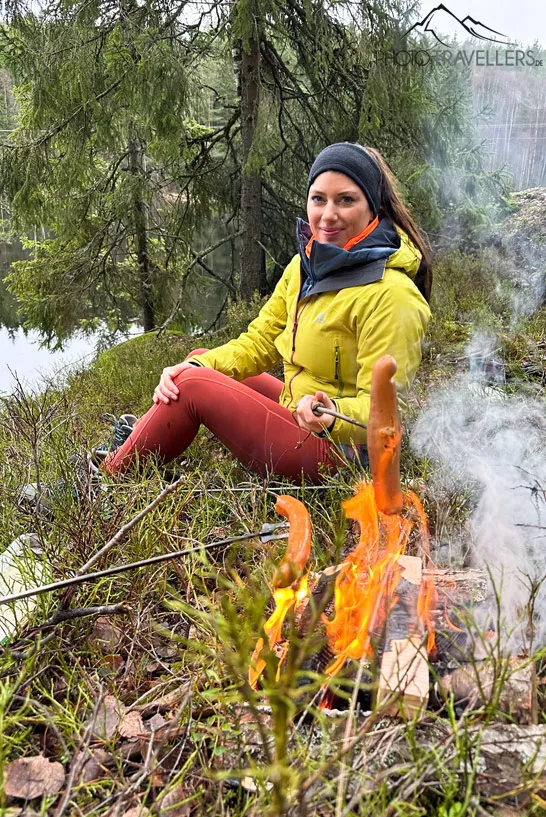
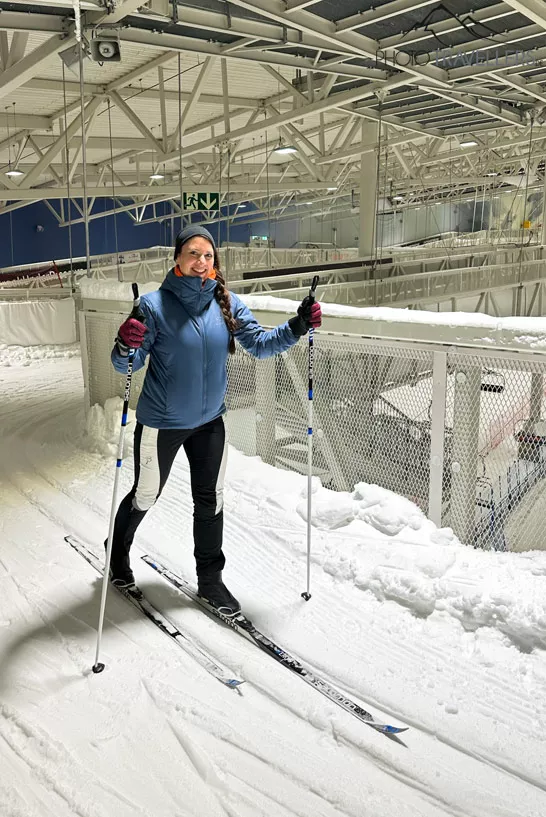
Arrival by fast train from the airport
There is a fast train from Oslo-Gardermoen Airport to Oslo city center. The train takes only about 20 minutes to cover the 50-kilometer distance. You can hardly get to Oslo easier and more comfortable.
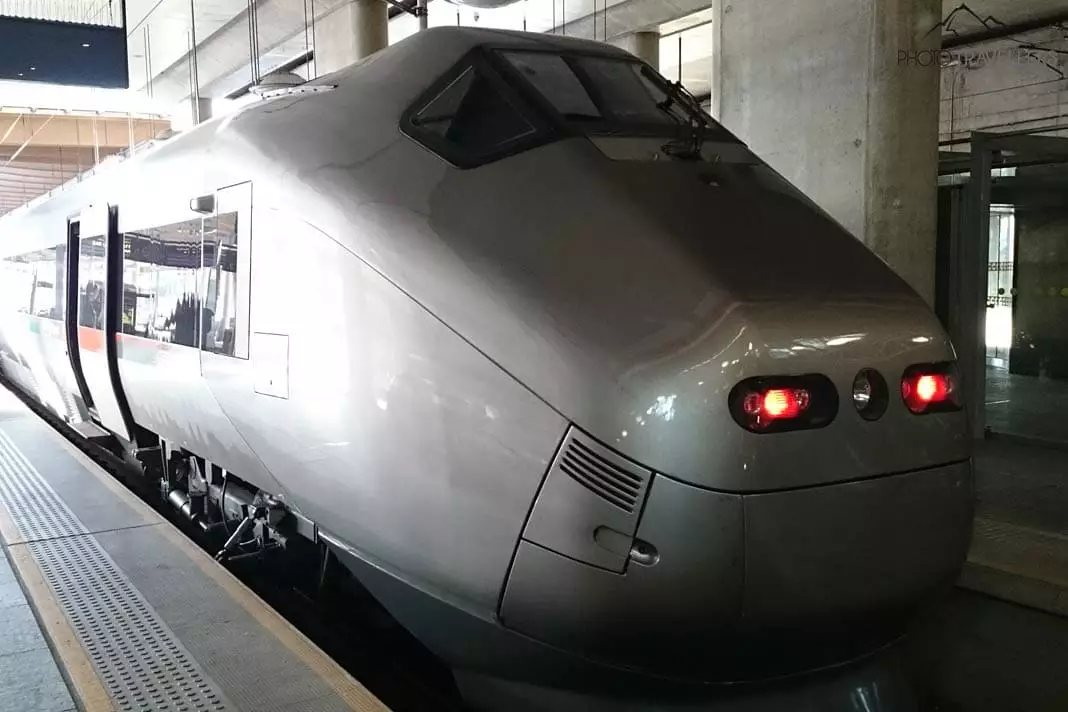
Important museums in Oslo
The city’s museums are also worth seeing. Especially when the weather is bad, a visit to a museum is the best thing to do in Oslo after all.
- Norwegian Open Air Museum – the open air museum (Norsk Folkemuseum) offers its visitors 155 traditional Norwegian buildings. Address: Museumsveien 10 (Google Maps), admission costs about 15 euros (160 NOK).
- Natural History Museum – huge dinosaurs await you in this museum. You will also find the largest collection of natural science objects in Norway. The museum includes the botanical garden, greenhouses, and the zoological museum. Address: Sars’ gate 1 (Google Maps), admission costs about 11 euros (120 NOK).
- Technical Museum – Airplanes, cars and other machines, natural science and science – that’s what you can discover at the Technical Museum. Address: Kjelsåsveien 143 (Google Maps), admission costs about 15 euros (165 NOK).
- Viking Ship Museum – huge Viking ships await you here. Some of them even date back to the 9th century. Apparently, the ships were discovered in chieftain’s graves. Address: Huk Aveny 35 (Google Maps), admission costs about 11 euros (120 NOK).
- Munch Museum – the museum displays over 28,000 works of Munch. In addition, you can see personal items, books, and tools of the artist. Address: Tøyengata 53, admission for adults costs about 11 euros (120 NOK).
We hope our overview of the top sights in Oslo has helped you a bit in your travel planning 😊. Have fun in Norway’s capital.
